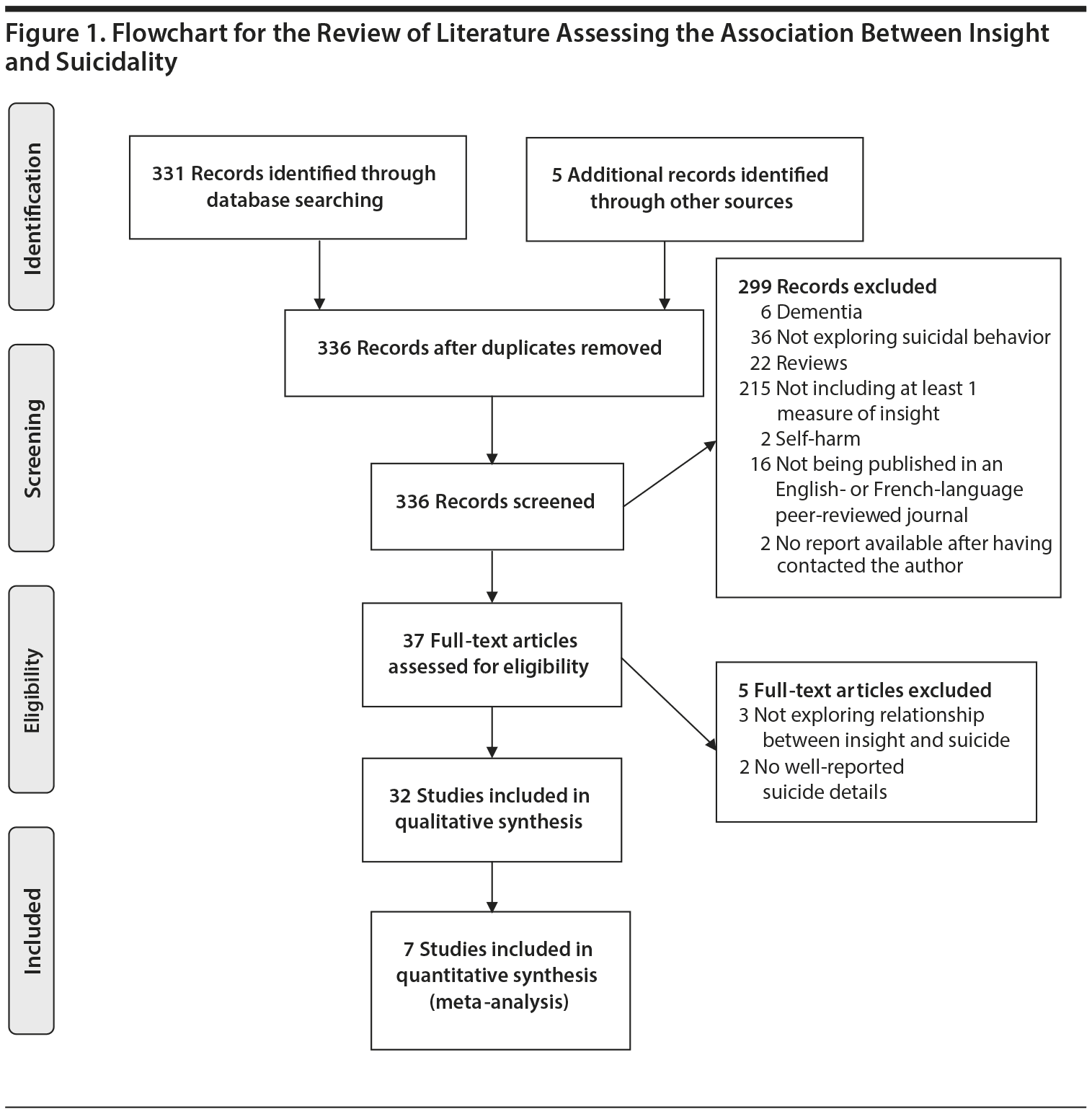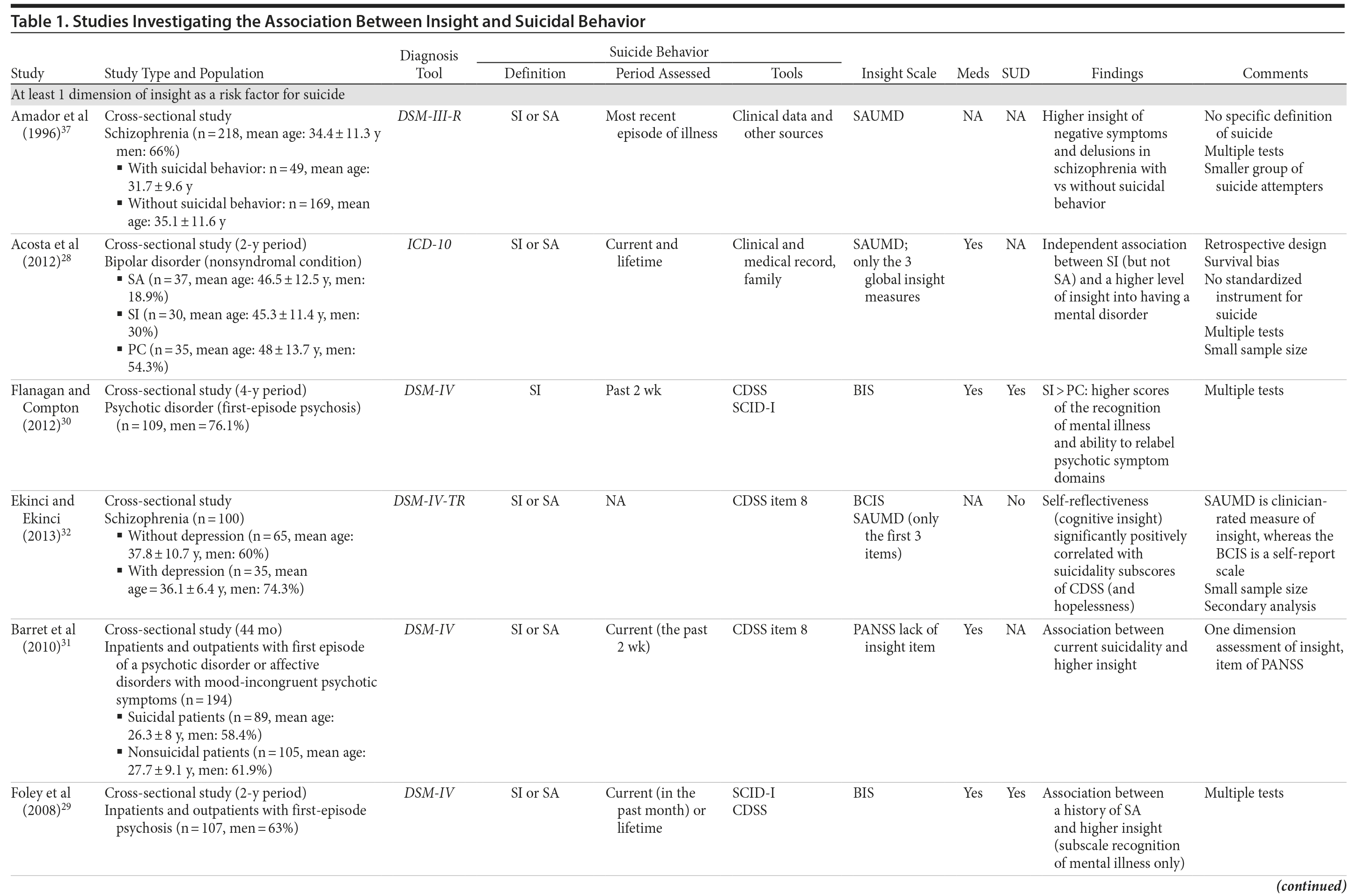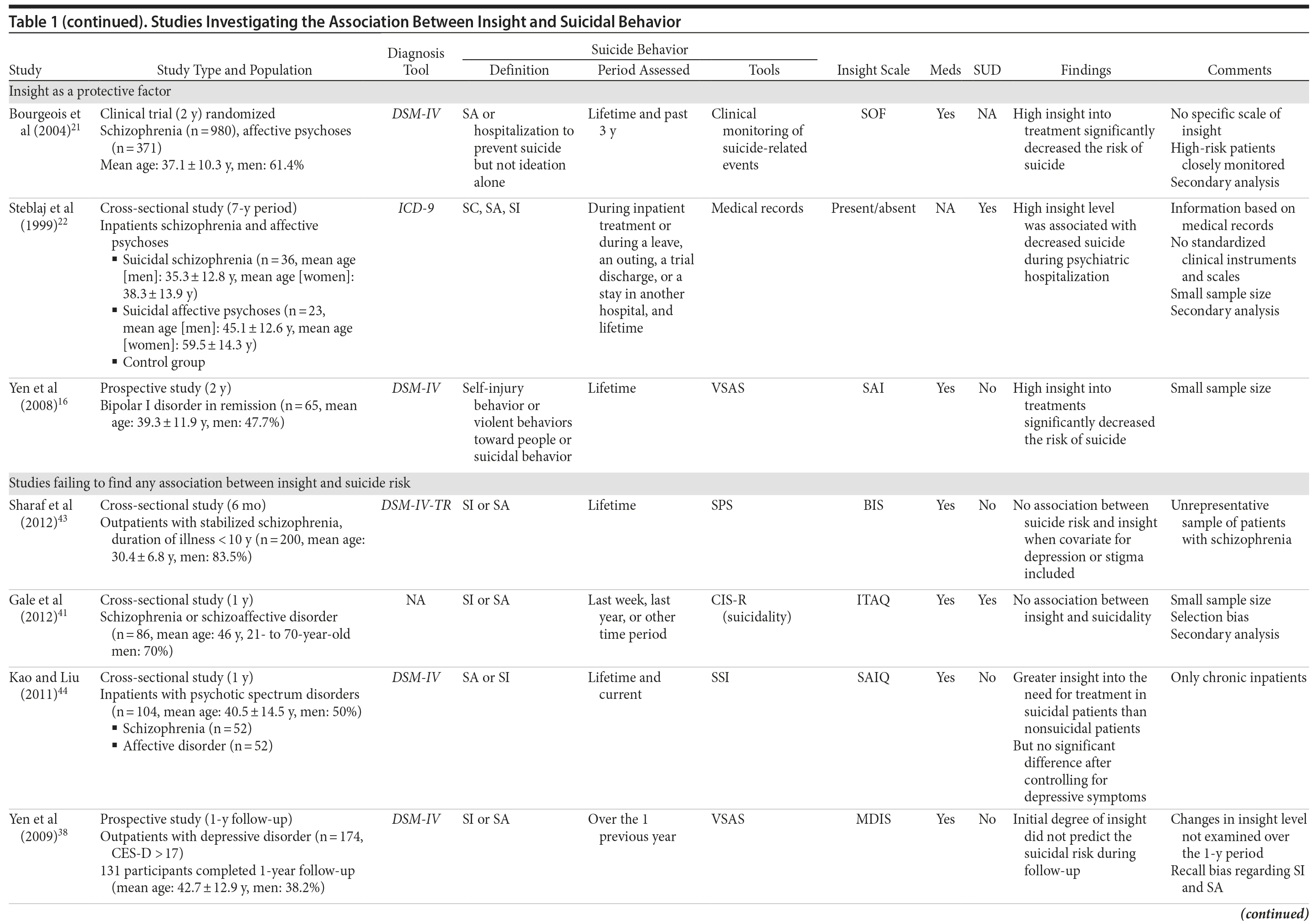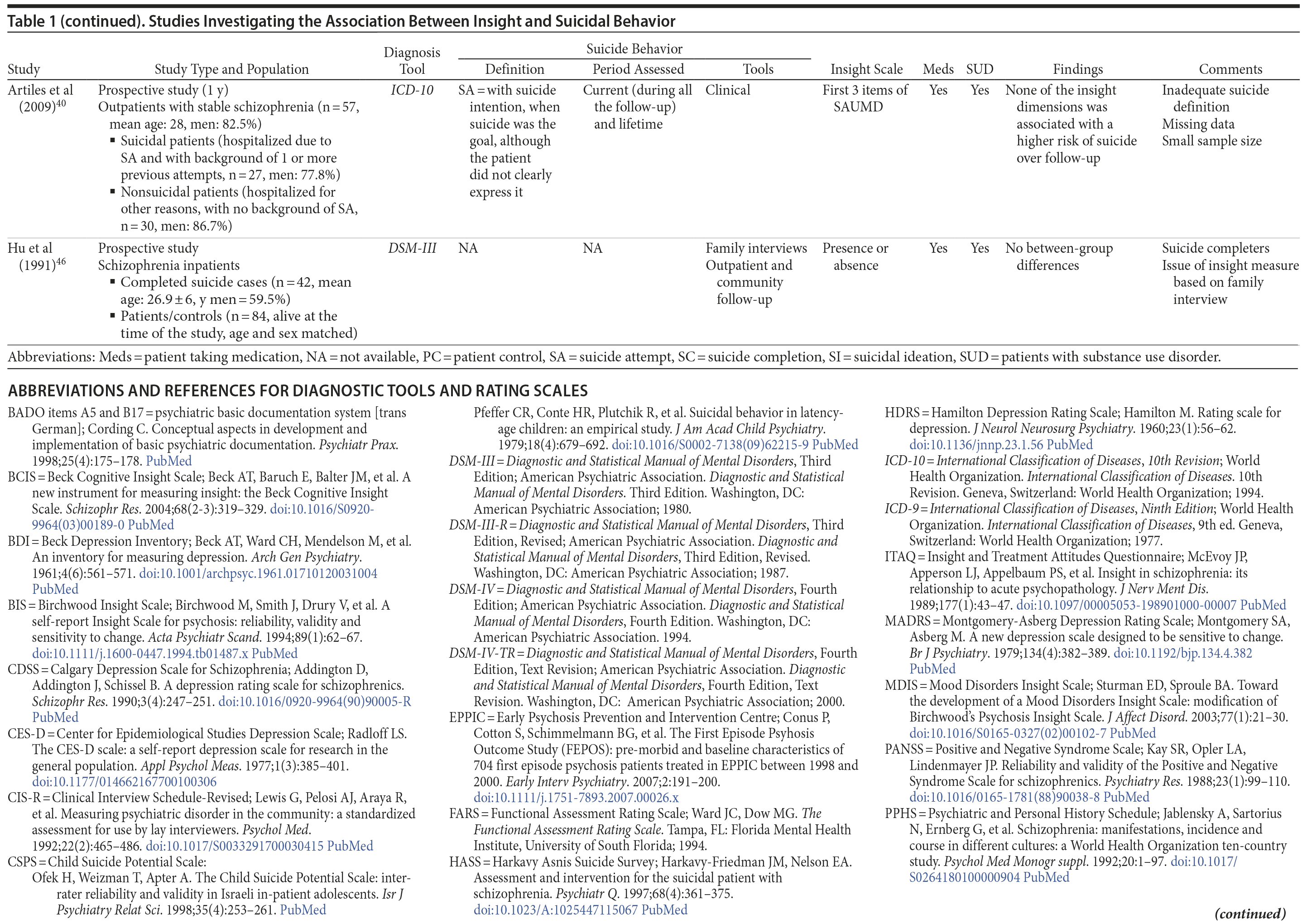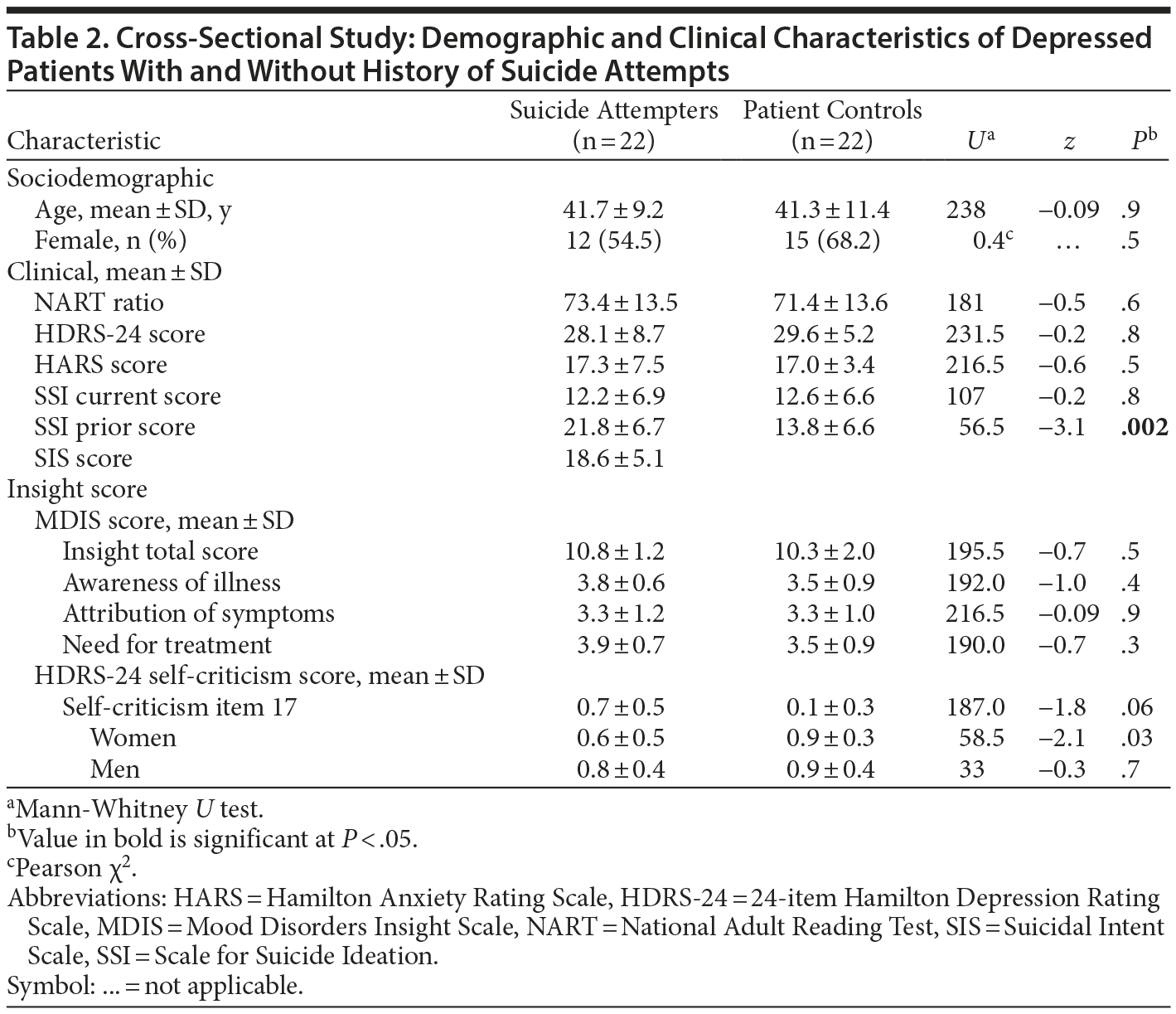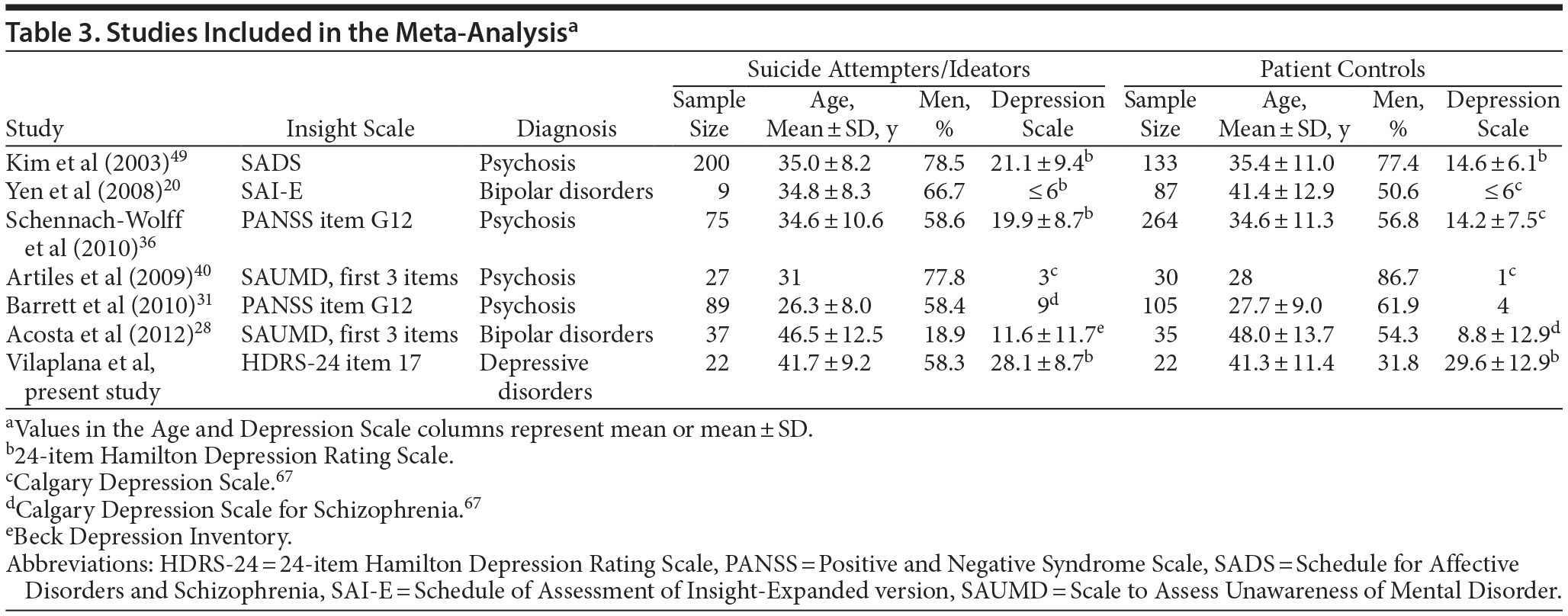Objective: To investigate the association between insight into mental disorders and suicidal behavior.
Data Sources: English and French MEDLINE databases up to January 2014 were searched using suicide combined with awareness, consciousness, insight and anosognosia, unawareness, and awareness of illness. We also conducted a cross-sectional study comparing Mood Disorder Insight Scale (MDIS) and 24-item Hamilton Depression Rating Scale (HDRS-24), item 17, performance between 22 depressed (DSM-IV-TR criteria) suicide attempters and 22 patient controls.
Study Selection: Study selection was based on the STROBE checklist. Selected studies were published in an English- or French-language peer-reviewed journal, included at least 1 measure of insight, and included patients with a history of suicidal behavior. Thirty-two studies were reviewed, of which 12 were longitudinal.
Data Extraction: A review of the literature and meta-analysis of studies were conducted to compare insight in patients with versus those without a history of suicidal behavior.
Results: Most studies (25) were conducted in psychotic disorders. A small majority showed a positive association between 1 measure of insight and higher risk of suicidal ideas or acts in both psychotic and mood disorders. Our study found that suicide attempters, mostly female attempters, tended to have better insight into depression than patient controls according to the HDRS-24 (P = .06, effect size = 1.43 [95% CI, 0.77 to 2.09]) but not MDIS. Finally, a meta-analysis of 7 studies confirmed significantly better insight scores in suicide attempters, with a small effect size (Hedges g = −0.16 [95% CI, −0.3 to −0.03]).
Conclusions: Overall, a significant but weak association was found between insight and the risk of suicidal behavior. We also raised methodological and conceptual concerns and discussed new measures (eg, test based).

Insight Into Mental Disorders and Suicidal Behavior: A Qualitative and Quantitative Multimodal Investigation

ABSTRACT
Objective: To investigate the association between insight into mental disorders and suicidal behavior.
Data Sources: English and French MEDLINE databases up to January 2014 were searched using suicide combined with awareness, consciousness, insight and anosognosia, unawareness, and awareness of illness. We also conducted a cross-sectional study comparing Mood Disorder Insight Scale (MDIS) and 24-item Hamilton Depression Rating Scale (HDRS-24), item 17, performance between 22 depressed (DSM-IV-TR criteria) suicide attempters and 22 patient controls.
Study Selection: Study selection was based on the STROBE checklist. Selected studies were published in an English- or French-language peer-reviewed journal, included at least 1 measure of insight, and included patients with a history of suicidal behavior. Thirty-two studies were reviewed, of which 12 were longitudinal.
Data Extraction: A review of the literature and meta-analysis of studies were conducted to compare insight in patients with versus those without a history of suicidal behavior.
Results: Most studies (25) were conducted in psychotic disorders. A small majority showed a positive association between 1 measure of insight and higher risk of suicidal ideas or acts in both psychotic and mood disorders. Our study found that suicide attempters, mostly female attempters, tended to have better insight into depression than patient controls according to the HDRS-24 (P = .06, effect size = 1.43 [95% CI, 0.77 to 2.09]) but not MDIS. Finally, a meta-analysis of 7 studies confirmed significantly better insight scores in suicide attempters, with a small effect size (Hedges g = −0.16 [95% CI, −0.3 to −0.03]).
Conclusions: Overall, a significant but weak association was found between insight and the risk of suicidal behavior. We also raised methodological and conceptual concerns and discussed new measures (eg, test based).
J Clin Psychiatry 2015;76(3):303-318
© Copyright 2015 Physicians Postgraduate Press, Inc.
Submitted: June 19, 2014; accepted September 25, 2014(doi:10.4088/JCP.14r09329).
Corresponding author: Fabrice Jollant, MD, PhD, Douglas Mental Health University Institute, Frank B. Common Building, 6875 LaSalle Blvd, Montréal (Québec), H4H 1R3, Canada ([email protected]).
According to the World Health Organization, 1 million people commit suicide and 10 to 20 times more attempt suicide each year in the world.1 The current assessment of suicide risk relies primarily on the assessment of multiple sociodemographic and clinical variables with relatively poor predictive power. One of the main risk factors for suicidal acts is mental disorders.2 Postmortem studies have reported the existence of mental disorders in more than 90% of cases of suicide victims.2 However, more than 90% of individuals with mental disorders will never commit suicide,3 suggesting that mental disorders may be necessary but not sufficient for carrying out suicidal acts. More specific factors must be sought to explain why some individuals commit suicidal acts during the acute phase of a mental disorder.
The stress-diathesis model of suicidal behavior, which postulates a vulnerability to suicidal acts (associated with genetic and early developmental components)4 is generally supported by the literature. Deficient cognitive functioning, notably disadvantageous decision making or reduced cognitive control, has been suggested as a vulnerability factor.5,6 Moreover, Joiner7 proposed that feelings of being a burden to others or of thwarted belongingness are important risk factors for suicide in conjunction with acquired capacity for suicide. In light of these models, we propose that insight into mental disorders could be another vulnerability factor enabling suicidal acts.
For instance, poor insight has been recognized as an important risk factor for adverse outcome not only in schizophrenia8-13 but also in depressive14,15 and bipolar16-18 disorders. One explanation could be low adherence to treatment due to the persistent belief of not being ill, which in turn facilitates recurrence of acute episodes. Adequate treatment of mental disorders has been associated with reduced risk of suicide19; therefore, persistent low adherence to treatment could increase the risk of suicide. Moreover, according to Joiner’s model,7 low insight may be related to the abnormally high subjective feeling of being alone and/or being a burden to others, increasing the risk of suicidal ideas. Equally, it is possible that high awareness of being ill in cases of severe mental disorders may lead to increased hopelessness, feeling of being a burden to family (eg, through objective negative consequences), and suicide risk.
Several studies have investigated the association between insight and suicidal behavior. While some studies have shown a significant association,10,16,20-37 others have not.38-49 In addition, many studies actually suggested that better insight is predictive of suicidal risk; therefore, a literature review on this topic is timely. Moreover, it is not clear if the link between insight and suicidal acts is specific to schizophrenia—in which many studies have been conducted—or if this is a transnosographic risk factor also affecting patients with mood disorders. This issue will also be examined as a part of our literature review.
Finally, insight is a complex construct. David50 and Amador et al12 have proposed a multidimensional conceptualization of insight in schizophrenia with 5 domains51: (1) awareness of illness, (2) capacity to relabel psychotic experiences as abnormal, (3) recognition of need for treatment, (4) attribution of symptoms to mental disorder, and (5) awareness of the social consequence of the illness.11,50 Additionally, a “cognitive insight” encompassing the evaluation and correction of distorted beliefs and misinterpretations52 has also been proposed. It is measured by the Beck Cognitive Insight Scale on 2 dimensions: self-certainty (certainty about being right and resistance to correction) and self-reflectiveness (expression of introspection and willingness to acknowledge fallibility).32 In sum, it is not clear if one dimension of insight may be more associated to the risk of suicidal act than others.
To answer these 3 questions, we simultaneously ran 3 complementary approaches: (1) we systematically reviewed the literature regarding the association between insight and suicidality; (2) we empirically tested insight in depressed suicide attempters with a high level of suicidal intent and depressed patient controls; and (3) we conducted a meta-analysis of studies comparing insight in patients with versus without a history of suicidal acts. We, therefore, aimed at clarifying the qualitative and quantitative relationship between insight and the risk of suicidal behavior, as well as establishing the strength of this relationship.

- The association between insight into mental illness and suicide risk should be clarified to improve prevention in both psychotic and mood disorders.
- Better insight, modulated by its different dimensions and other cognitive features, seems to play a significant but weak role in the risk of suicidal behavior.
METHOD
Systematic Review of Literature
Data sources. An English and French systematic MEDLINE literature search of clinical trial, cohort, case-control, and cross-sectional human studies published up to January 31, 2014, was performed. The following medical subject heading (MeSH) term suicide was combined with the MeSH terms awareness and consciousness and with the title and abstract terms insight and anosognosia, unawareness, and awareness of illness. An iterative process was used to ensure that all relevant articles were obtained. An additional manual search through the bibliographical references of extracted articles and existing reviews was conducted to identify potential studies not captured in the electronic database searches.
Study selection. Abstract selection was based on the Strengthening the Reporting of Observational studies in Epidemiology (STROBE) checklist, which describes items that should be included in reports of studies. Abstracts identified through the literature search were independently evaluated by 2 reviewers (M.V. and S.R.D.) and selected by a consensus from all authors.
Studies that met the following inclusion criteria were included in this systematic review: (1) published in an English- or French-language, peer-reviewed journal; (2) included at least 1 measure of insight; and (3) included patients with a history of suicide attempt or suicidal ideas. Full articles were then obtained for final review. The study selection process is shown on a chart flow diagram in Figure 1.
Of the 331 originally identified abstracts, 32 studies10,16,20-49 met the inclusion criteria for this systematic review (Table 1).
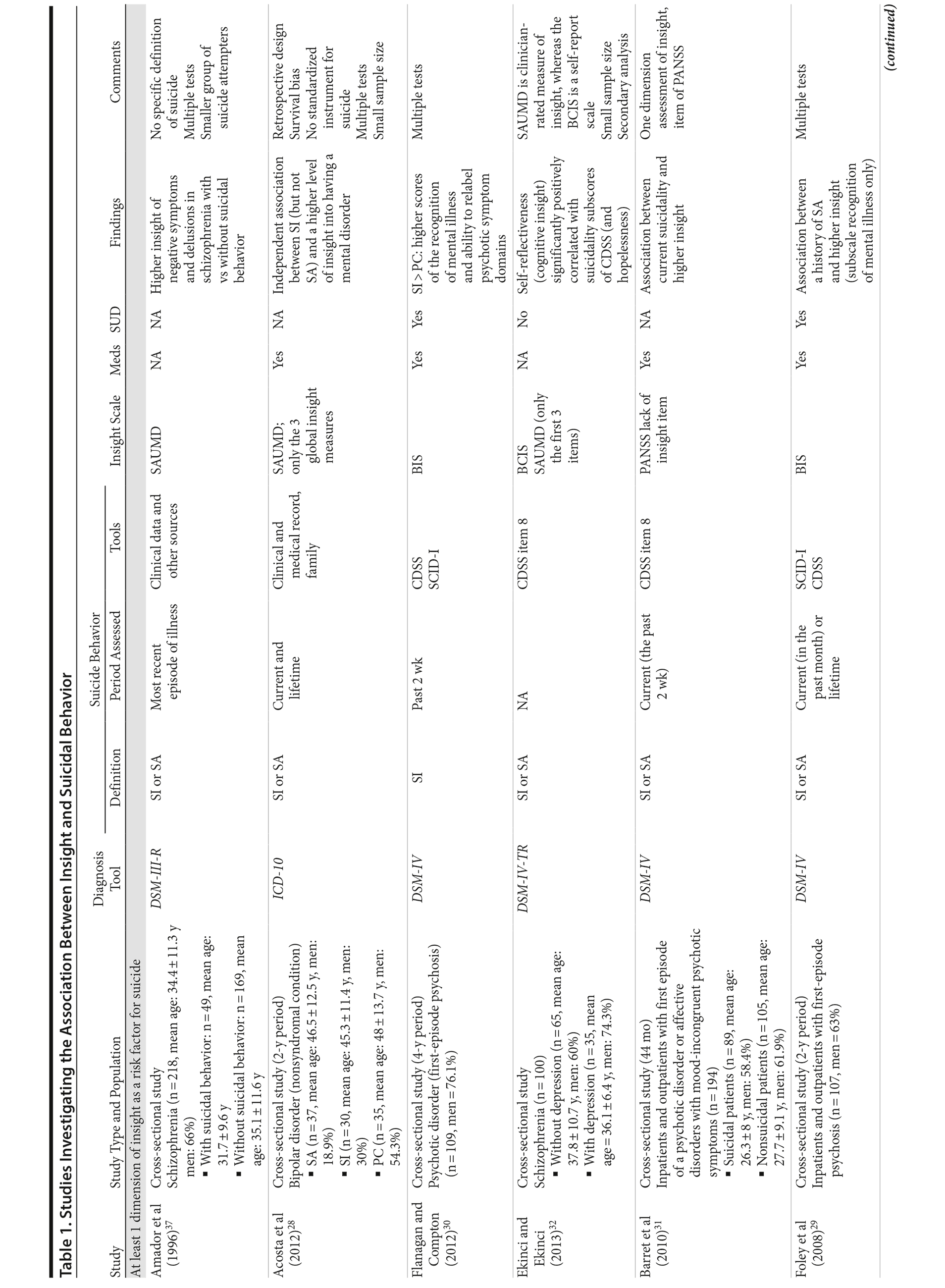
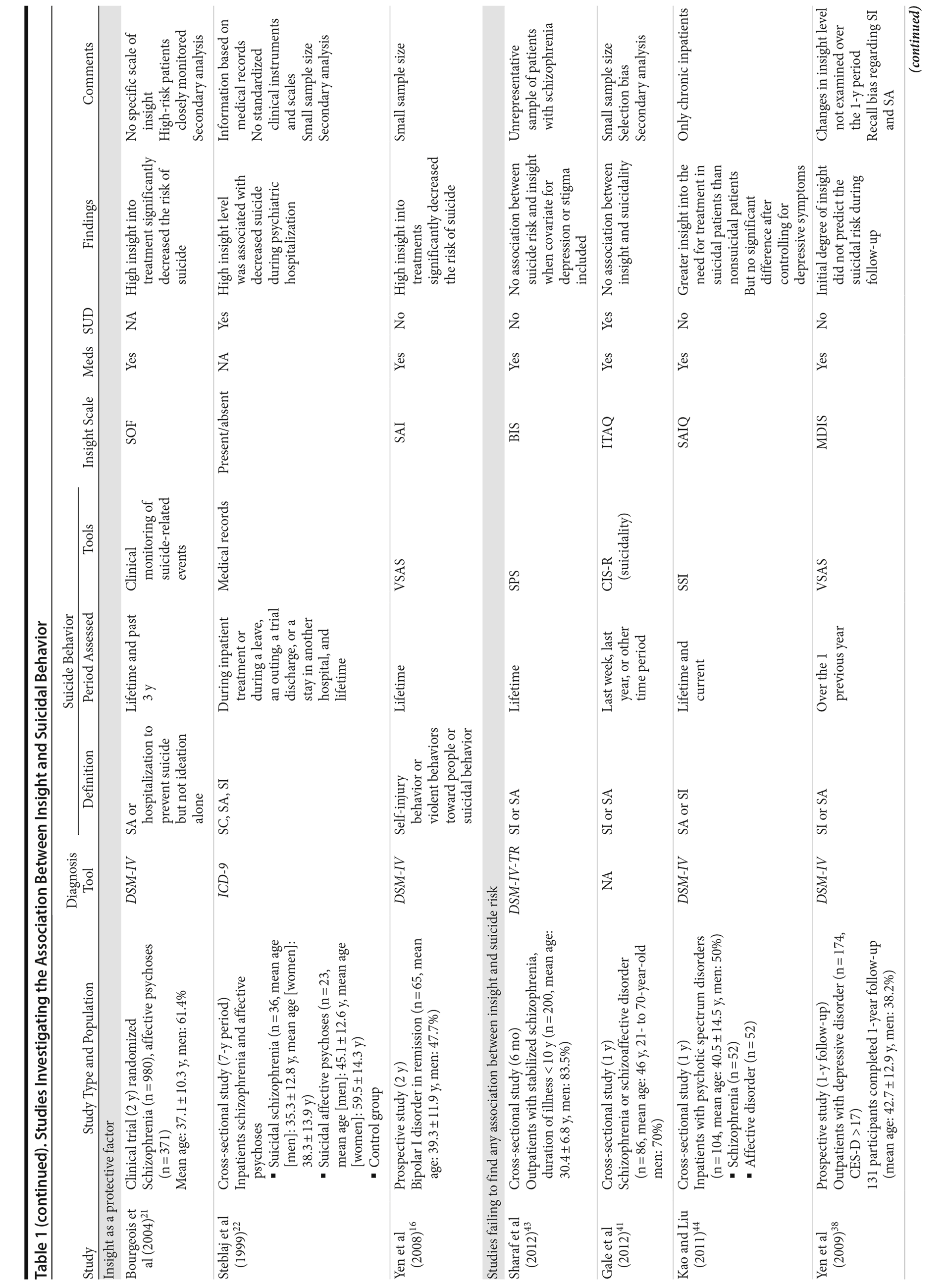
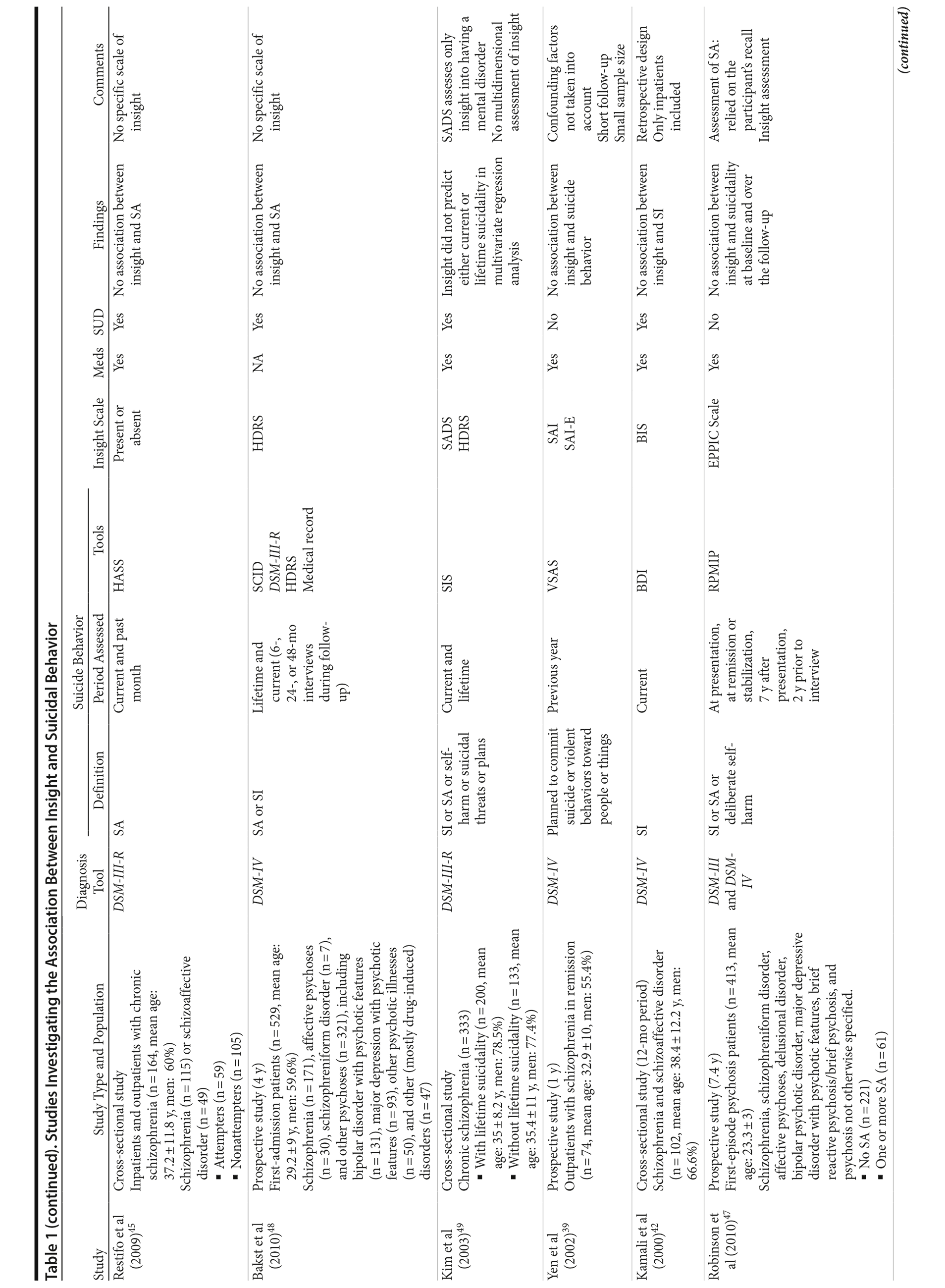
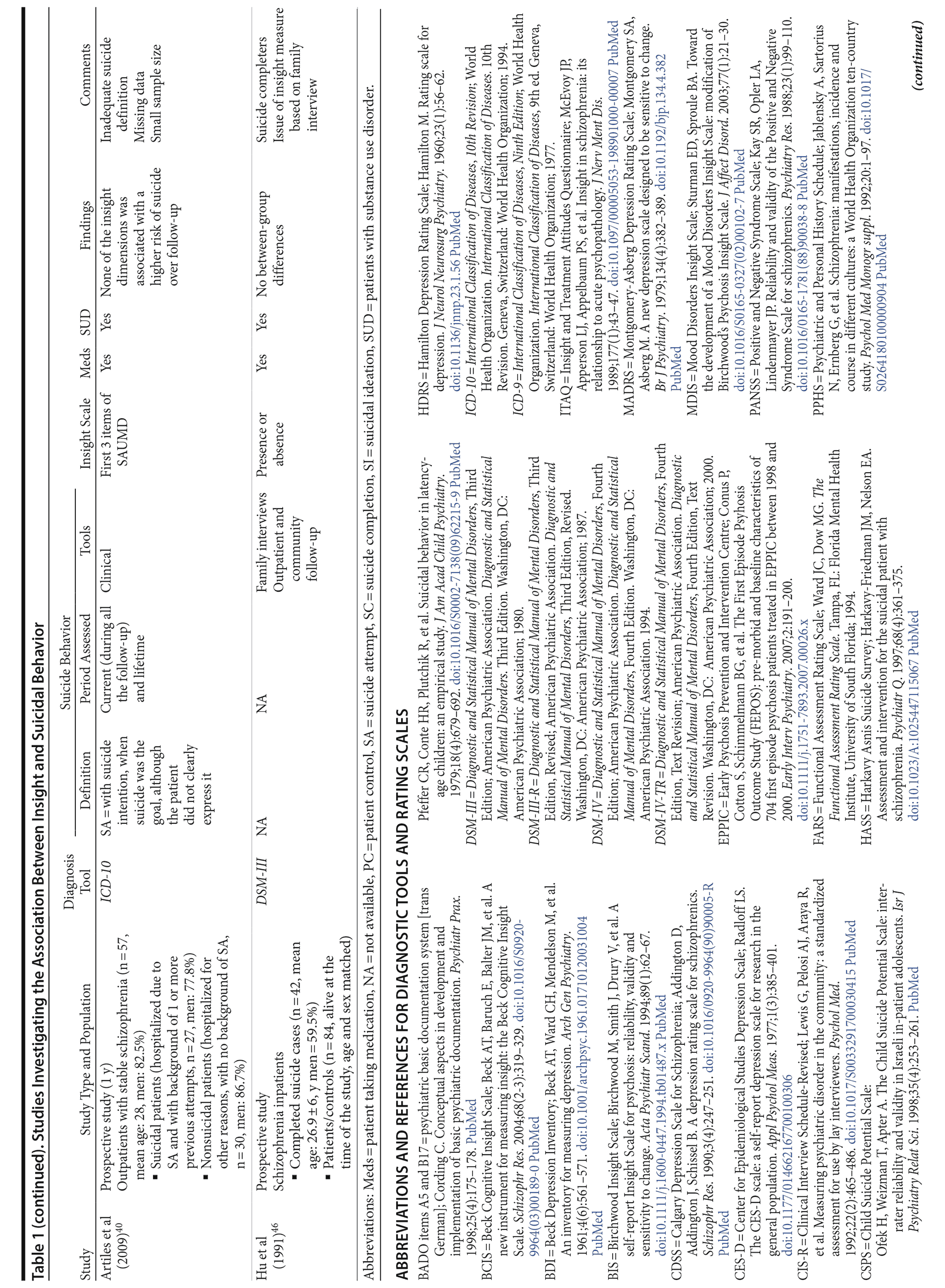

The quality of each study was assessed independently by 2 reviewers (M.V. and S.R.D.) using the Crombie criteria adapted by Petticrew and Roberts.53
Cross-Sectional Study
Population and clinical assessment. This study was conducted at the Douglas Mental Health University Institute, Montreal (Quebec, Canada), and was approved by the local research ethics board. All participants signed an informed consent form prior to their participation.
Two groups of participants aged between 18 and 65 years were recruited: (1) 22 outpatients with a current major depressive episode, major depressive disorder (according to DSM-IV-TR criteria), and a personal history of suicide attempt (suicide attempters) and (2) 22 outpatients with a current major depressive episode or major depressive disorder but without a lifetime history of suicidal act (patient controls). All participants were depressed at the time of assessment, with a score above 20 on the 24-item Hamilton Depression Rating Scale (HDRS-24).54 Patients with schizophrenia, bipolar disorder, a history of alcohol/drug abuse or dependence over the last 6 months, or a history of severe general medical condition were excluded.
We used the most common definition of suicide attempt, ie, “any act carried out with a certain intent to die and different from self-mutilations.”4 In addition, to avoid including patients who committed only dubious or ambiguous acts and thus reduce possible heterogeneity, suicide attempters had to have committed at least 1 intentional act with a Suicide Intent Scale (SIS)55 score above 15/30.
Information about personal and family history of suicidal behavior was obtained from medical files, an interview with the patient and the Colombia Suicide History Form. The Scale for Suicide Ideation (SSI)56 and the SIS were used for the last and the most severe suicidal act. The Hamilton Rating Scale for Anxiety (HARS)57 was additionally used to quantify anxiety levels. Verbal IQ was assessed with the National Adult Reading Test (NART).58,59
Insight assessment. Insight was assessed with the French or English versions of the Mood Disorders Insight Scale (MDIS)60 and with the insight item of the HDRS-24.54 The MDIS is an 8-item scale that measures 3 dimensions of insight: awareness of illness, attribution of symptoms, and belief in the necessity of treatment. The MDIS items were presented as a series of statements, and the participants were asked if they agreed or disagreed with or were unsure about them. For example, the first item in the dimension “necessity of treatment” is “I need to be seen by a psychiatrist (or doctor).” If the subject disagrees with or is unsure about the statement, he or she will be further asked whether he or she agrees with the item “there was a time when I needed to be seen by a psychiatrist (or doctor).” A global score was also calculated. Higher MDIS scores indicate a better insight.
The HDRS-24 assesses insight with item 17 (self-criticism) as follows: 0 = acknowledges being depressed and ill; 1 = acknowledges illness but attributes cause to bad food, climate, overwork, virus, need for rest, or others causes; and 2 = denies being ill at all. Higher HDRS-24 scores indicate a lower insight. It therefore represents a mix of the 2 dimensions “awareness of illness” and “attribution of symptoms.” The HDRS-24 item 17, by integrating awareness and attribution of symptoms, may have a better naturalistic validity than the MDIS, which artificially separates both dimensions. In addition, it is a much simpler measure.
Statistical analysis. The Shapiro-Wilk test showed a nonnormal distribution for most of the scores, so nonparametric tests were used. Mann-Whitney and Kruskal-Wallis tests were used to compare quantitative variables. A χ2 test was used to compare qualitative variables. Spearman correlation tests were also used. A conservative P value = .01 was used, taking into account multiple comparisons (5 dimensions). All analyses were performed using SPSS 15.0 (SPSS, Inc; Chicago, Illinois).
Meta-Analysis
Of the studies selected for the review, we used those that met the additional inclusion criterion of comparing at least 2 groups of which 1 comprised patients with a history of suicide attempt and/or suicide ideations and 1 group of patients without any personal history of suicidal act or suicide ideations. Of the 32 studies used in the systematic review, 7 studies met this criterion, including our own study (see Table 3).
Data extraction and analyses. A standardized form was used to extract data, which included authors, date of publication, study design, settings, study population, insight scales used, definition of suicidal behavior, and insight (mean and standard deviation). Two groups were compared: Suicide attempters/ideators (patients with a personal history of suicide attempt or suicide ideations) and patient controls (ie, patients with no personal history of suicidal act but with a history of mental disorders).
Analyses were performed using the Comprehensive Meta-Analyses Version 2.0 (Biostat, Englewood, New Jersey) and IBM SPSS Version 20 (IBM Corporation; Chicago, Illinois). We used a random-effects model, as we assumed a priori that the true effect sizes most likely vary between the included studies.61 Pooled Hedges g effect sizes for the subjects’ insight scores and depression ratings were computed.62 The obtained effect sizes are usually considered small if < 0.3, moderate if between 0.4-0.8, and large if > 0.8.63
Heterogeneity was assessed using the Q statistic and the I2 index.64 Values of P < .10 for the former and > 35% for the latter were deemed as indicative of study heterogeneity. Finally, we used funnel plots, Rosenthal’s fail-safe N,65 and Egger regression intercept66 to test for the presence of publication bias.64
RESULTS
Systematic Review
The systematic literature review identified 32 studies (Table 1). Patients’ mean ages ranged from 17.5 to 59.6 years, and the rate of men ranged from 18.9% to 86.7%.
Twenty-five studies included patients with psychotic disorders (both schizophrenia or schizophreniform disorder or delusional disorder or psychotic disorder not otherwise specified, and schizoaffective disorder).10,21,22,24-27,29,30,32-37,39-47,49 In 6 of these studies, patients presented a first episode of psychosis24,27,29-31,47 and in 2 of them, a mood disorder with psychotic features.24,47 Four studies recruited patients with mood disorders, both euthymic bipolar disorders16,20,28 and depressive disorders.38 In 3 studies, diagnoses were mixed, including psychosis, bipolar and recurrent mood disorders together23; or psychosis, depressive disorder or bipolar disorder with psychotic features31 and drug-induced disorders.48
Insight was assessed in 21 studies with 7 different specific, quantitative and multidimensional scales, including Scale to Assess Unawareness of Mental Disorder (SAUMD),10,28,32-35,37,40 Birchwood Insight Scale (BIS),26,29,30,42,43 Schedule of Assessment of Insight (SAI)16,39 or SAI-Expanded version (SAI-E),20,27,39 Insight and Treatment Attitudes Questionnaire (ITAQ),25,41 Self-Appraisal of Illness Questionnaire (SAIQ),44 and Mood Disorders Insight Scale (MDIS).38
Cognitive insight was assessed in addition to clinical insight (SAUMD) in 1 study using the Beck Cognitive Insight Scale (BCIS).32 Insight was dichotomized into present or absent in 4 studies22,23,45,46 and categorized into full, partial, or no insight in 3 studies based on the Early Psychosis and Intervention Centre intake mental state examination (EPPIC)24,47 and Schedule for Affective Disorders and Schizophrenia (SADS).49 Insight was also assessed using items of nonspecific scales, including HDRS-24 item 17,49 Positive and Negative Syndrome Scale (PANSS) item G12,31,36 and Scale of Functioning (SOF) item 12.21 Among these measures, some map onto the global dimension of insight (SADS, PANSS, EPPIC, MDIS, SAI, SAI-E, SAUMD, HDRS-24, SOF, dichotomous scales), the recognition of mental illness (SAUMD, SAI-E, BIS, MDIS, SAI, ITAQ), the attribution of symptoms to disorder (SAUMD, SAI-E, BIS, MDIS, SAI), the recognition of the need for treatment (SAUMD, SAI-E, BIS, SAIQ, MDIS, SAI, ITAQ), or the beliefs about social consequences and outcome of disorder (SAUMD, SAIQ).
Twelve studies were prospective and 20 were cross-sectional and retrospective.
Overall, a small majority of studies reviewed showed a significant association between at least 1 measure of insight and suicidal behavior: 17 studies (12 in psychotic disorders, 2 in mood disorders, and 3 in combined disorders) showed at least 1 measure of better insight as a risk factor for suicidal acts, whereas 3 (2 in psychotic and 1 in bipolar disorders) showed better insight in the necessity of treatment as a protective factor for suicide. Twelve studies failed to find any association: 9 in psychotic disorders, 1 in mood disorders, and 2 in combined disorders. More detailed results for each insight dimension are presented below.
Global insight. Four studies (including 2 prospective studies) found an association between better global insight and suicidal behavior in general in psychotic patients.31,36 Insight was found as a risk factor for both suicidal ideations and suicide attempts in patients with diagnosis of schizophrenia, depressive, or bipolar disorders23 and for self-harm, suicide attempts, and suicide completion in first psychotic episodes.24
However, 5 prospective studies did not find any significant association between general insight and suicidal behavior, including in depressive38 and schizophrenic26,39,40 disorders, and in first-admission patients with psychotic, mood, or drug-induced disorders.48 Similarly, 2 prospective studies45,49 and 2 retrospective studies46,47 did not find any difference between suicide attempters and nonattempters in chronic psychotic disorders or in first-episode psychosis, even after multivariate analysis. Of note, among these negative studies, 4 had a small sample size,26,39,40,45 which may have contributed to false-negative results.
Recognition of mental illness. Seven studies (including 2 prospective studies) showed a positive association between better recognition of mental illness and suicide attempts,26 suicidal ideation,25,30 mixed suicide attempts and suicidal ideation,29 or self-harm and suicide attempts together27 in patients with schizophrenia. Insight was found as a risk factor for both suicidal ideation and suicide attempts in bipolar patients.20,28
Nine other studies (including 3 prospective studies) reported no significant association in schizophrenic patients with suicidal behaviors,34,37,39-41 suicidal ideas,33,42 or self-harm,35 including 1 study in adolescents.10
Multiple tests were used in several studies. Five negative studies and 4 positive studies had small sample sizes.
Attribution of symptoms to disorder. Four studies showed a positive association between higher recognition of psychotic symptoms and suicidal acts in schizophrenic10,37 or bipolar patients28 or of suicidal ideas in schizophrenic patients.30
Three studies (including 1 prospective) found no significant associations,39,42 even after taking into account confounding factors, including depression or stigma43 in patients with schizophrenia.
Three positive studies had a small sample size.10,28,37 Three studies did not correct for multiple tests10,30,37 that may have led to false-positives. One negative study had small sample size.39
Recognition of the need for treatment. Among 14 studies evaluating the need for treatment, 5 (including 2 prospective studies) reported greater recognition for requiring treatment in suicidal patients with schizophrenia25,33-35 or bipolar disorders20 compared to nonsuicidal patients; however, 3 of the studies20,33,34 did not correct for multiple comparisons. Conversely, 3 studies (including 2 prospective studies) showed insight into treatment as being a protective factor, specifically, of future suicide attempts in schizophrenic patients over the 2-year period of follow-up,21 of self-injury and suicidal acts in bipolar patients in remission at entrance,16 and, in the retrospective study, of suicide attempts, suicide completions, and suicidal ideations.22
Seven studies reported no significant difference27,37,41-44 or no predictive value of this dimension of insight39 in schizophrenic patients.
Of note, 2 positive16,22 and 4 negative studies27,37,39,41 had a small sample size.
Beliefs about social consequences and outcome of disorder. In schizophrenic patients, 1 study33 found a positive association (without taking into account multiple comparisons) between better recognition of the social consequences of the disorder and suicidal ideation or intent. Seven studies found no association32,34,37,44 in schizophrenic patients (including 2 prospective studies35,40) or in bipolar patients.28
Of note, 4 studies28,32,37,40 had a small sample size.
Cognitive insight. To our knowledge, only 1 study assessed cognitive insight and reported a positive association between suicidal behavior and higher “self-reflectiveness” (but not with self-certainty) of the cognitive insight scale in schizophrenic patients.32 However, this study had a small sample size, and the relationship between suicidality and insight was a secondary analysis.
Cross-Sectional Study
The 2 groups were statistically similar in terms of age, gender, HDRS-24, HARS, and NART scores (Table 2). As expected, mean scores of suicidal ideation (SSI) were higher in suicide attempters than in patient controls.
Suicide attempters and patient controls were similar in terms of MDIS insight total score (U = 195.5; z = -0.66; P = .5) and for its 3 subscores (recognition of awareness of mental illness, attribution of symptoms, and need for treatment). A trend was found for better insight in suicide attempters compared to patient controls on HDRS-24 item 17 (U = 187.2; z = −1.8; P = .06) (Table 2), with a large effect size of 1.43 (95% CI, 0.77 to 2.09). Post hoc analyses revealed that this difference was mainly found in women (U = 58.5; z = −2.1; P = .03) and not men (U = 33; z = -0.29; P = .7). A 2-sided tailed power analysis with an α value = .01 showed 92% power for detecting significant differences.
No significant correlation was found between the HDRS-24 insight score and the total MDIS score (Ï = 0.3; P = .8) or with any of the 3 MDIS subscale scores: awareness (Ï = 0.02; P = .9), attribution of symptoms (Ï = 0.1; P = .5), and need for treatment (Ï = −0.09; P = .6). We found no correlation between the HDRS-24 insight score and the SIS in suicide attempters (Ï = -0.02; P = .9) or the SSI in suicide attempters (Ï = −0.05; P = .8) or in patient controls (Ï = 0.3; P = .2).
Meta-Analysis
Seven studies20,28,31,36,40,49 including our own study were included, comprising 1,135 participants, of whom 459 were suicide attempters or ideators (mean ± SD age = 35.9 ± 9.7 years; 59.6% males) and 676 were patient controls (35.8 ± 12.5 years; 59.9% males) (Table 3). The following scores were extracted from the different studies: the HDRS-24 insight score for our own study, the SADS score,49 the SAI-E score,20 the PANSS item G12 score,31,36 and the scores from the 3 first items of the SAUMD.28,40
The pooled Hedges g effect size between suicide attempters/ideators and patient controls was −0.16 (95% CI, −0.3 to −0.03; z = −2.42; P = .015) (Figure 2), representing a significant but small effect size and indicating that suicide attempters/ideators had significantly better insight than patient controls. The fail-safe N, ie, the number of unpublished or missing null findings that would be needed to render the results nonsignificant, was 9. Heterogeneity exceeded that expected by chance at P < .05, implying that the variance among the effect sizes was greater than that expected by sampling error. The study by Yen et al20 was most likely responsible for the heterogeneity related to the insight score. After excluding this study, the heterogeneity disappeared and the result became more significant (pooled Hedges g effect size = −0.2 [95% CI, −0.32 to −0.06]; z = −2.97; P = .003). The funnel plot was reasonably symmetrical, suggesting a low risk of publication bias. Moreover, the more conservative Egger regression intercept suggested no publication bias.
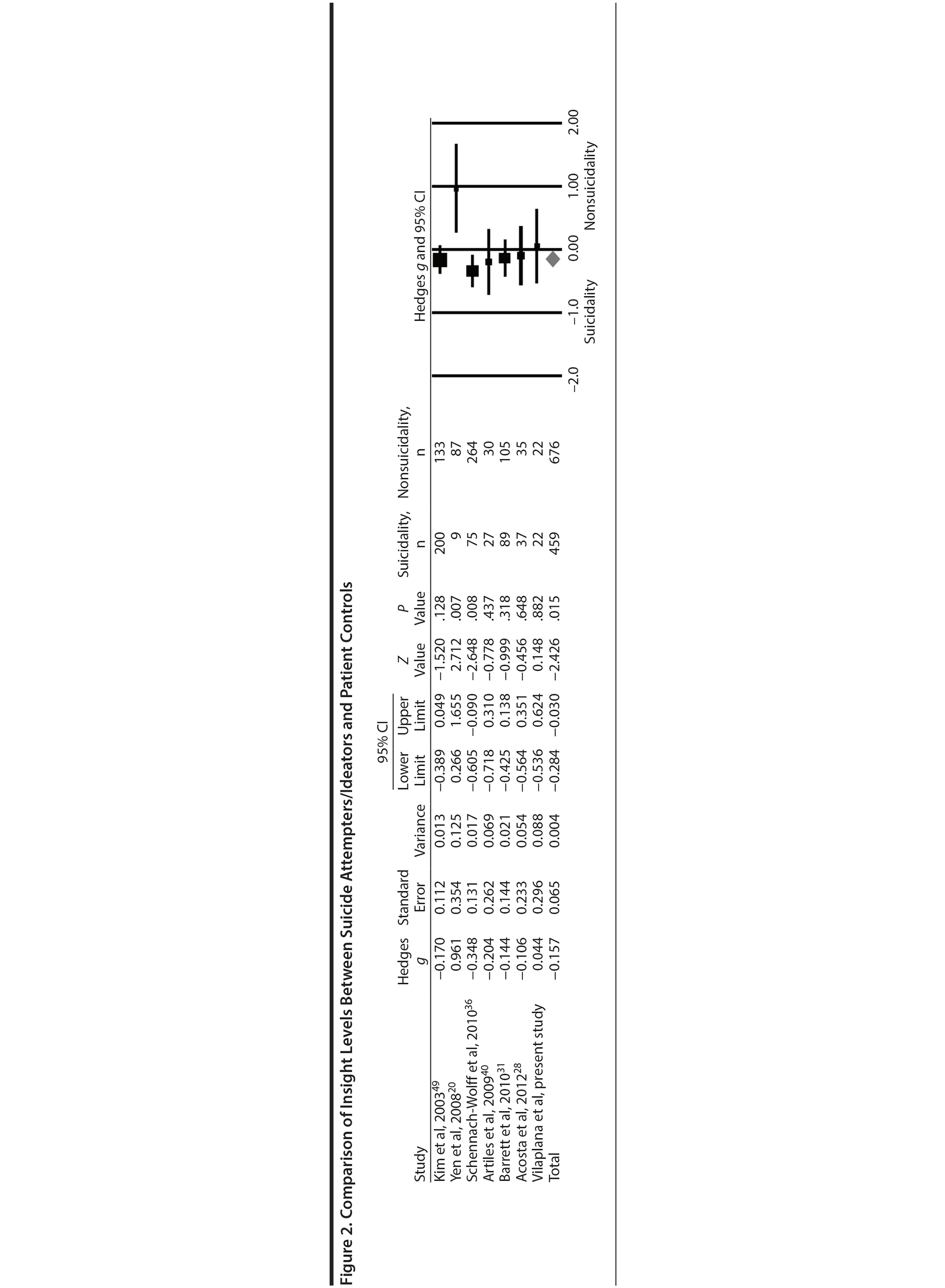
DISCUSSION
In this multimodal investigation comprising a systematic qualitative review of literature, a cross-sectional study, and a quantitative meta-analysis, we found a significant but weak association between insight and suicidality. Our literature review revealed that a small majority of studies reported at least 1 dimension of insight being associated with either a history of suicide attempt or suicidal ideation in retrospective studies or a risk of suicide attempt or self-harm in follow-up prospective studies. Our own study showed a trend toward an association between insight as measured by the simple item 17 of the HDRS-24 and suicide attempt in women (but not the more complex MDIS). Finally, our meta-analysis of 7 studies, including 4 in psychosis, 2 in bipolar disorder, and 1 in depressive disorder, showed a significant but small effect size (pooled Hedges g = −0.16) in the comparison between suicide attempters/ideators and patient controls with similar comorbid diagnoses.
Commonly, the association between these variables suggests that better insight is a risk factor for suicidal ideation and acts. This is particularly true for the dimensions “recognition of mental illness” and “attribution of symptoms to the disease” and less often for “recognition of the need for treatment” and “beliefs about consequences.” In addition, 3 studies (2 prospective and 1 retrospective) reported the opposite, showing lower “recognition of the need for treatment” as predicting suicidality (vs 5 studies which reported a positive association and 7 studies, no association).
Another question was the role of diagnosis in moderating the association, or the direction of the association, between insight and suicidality. This is relevant, as previous studies have suggested that diagnosis intervenes in the relationship between cognition and suicidal behavior. For example, low IQ scores have been associated with increased risk of suicidal behavior but only in nonpsychotic patients.68 In addition, suicide attempters with schizophrenia tended to outperform nonattempters in executive functioning, namely attention and verbal fluency69 and cognitive flexibility,49,69 whereas depressed suicide attempters had worse executive performance compared to patients without such a history.6 Moreover, psychiatric disorders are hypothesized to involve different mechanisms of insight.70 In psychosis, impaired insight would be underpinned by a loss of contact with reality, whereas in nonpsychotic illness, it would be the result of a defense mechanism against an intolerable reality.70 However, to our knowledge, there is no empirical argument to support these different mechanisms.
The restricted number of studies available in mood disorders, notably in comparison to psychotic disorders, prevents separate meta-analysis and limits any definite conclusions about potential moderating effects of diagnosis. However, positive associations between insight and suicidality were found in both psychotic disorders and mood disorders, including bipolar and depressive disorders. Studies reporting an increased risk of suicide among older adults diagnosed with dementia, especially during the early course of the disease,71,72 when insight is preserved,73 also suggest a transnosographic association between insight and suicidal behavior. Several clinical examples show that good insight into the nature of dementia and its ultimate outcome increases suicide risk, even when depression is absent.74
Interpreting the association between insight and suicidality is not easy. The weakness of the effect size further suggests that additional processes have a mediating or moderating effect in this relationship. Suicidal behavior has indeed been associated with many cognitive deficits.75 It is common to consider that better insight about the illness and its related consequences to life prospects may lead to greater hopelessness, resulting in a higher risk of suicidal ideas and acts. Specifically, this explanation has been proposed for young patients with schizophrenia. However, we did not find a strong link between insight of the consequences of disorder and suicidality. Possibly of greater consequence is the feeling that symptoms are attributable to an internal disorder and, therefore, it may be the individual himself/herself who is to be blamed rather than an external agent.
Additionally, the patient may have the feeling that nothing can be changed. This is suggested by 3 studies, 16,21,22 including 2 prospective studies,16,21 showing lower recognition for treatment in at-risk patients. Depressed patients with a history of suicide attempts display a disconnection between what they “know” (explicit understanding) and what they “do”76: Those who know the advantageous options rarely choose them, contrary to patients without a history of suicide attempt. Preliminary analyses from our study suggest that patients with explicit understanding on the Iowa Gambling Task, a card game, have better insight on the HDRS-24 insight item than those who have no explicit understanding (mean scores = 0.8 ± 0.4 vs 0.4 ± 0.5; U = 35; P = .052). In line with the findings in decision making, the effect of insight (as a particular measure of explicit understanding) may be counterbalanced by the inability of these individuals to transform insight (eg, “I’ m sick”) into positive choices and acts (eg, “I need treatment and I will take it”). Although this interpretation does not explain why attempters would have better insight, it may explain the apparent disconnection between advantageous ideas and damaging choices in these individuals. These results also support the development of cognitive tests to measure insight beyond self-reports with the risk of desirability bias and the difficulty of self-examination and disclosure. More research in this field is required.
Limitations
Several important limitations have to be highlighted. First, scales used to measure insight varied and may therefore partly explain conflicting results, as stated in a previous meta-analysis77 limited to insight in patients with schizophrenia. In our own study, we found no correlation between the MDIS and HDRS-24 insight scores. Different subscores have also been used to take into account the complexity of the construct. Moreover, the different scales do not always assess the exact same dimensions, which complicates any firm conclusion. However, 2 studies8,78 suggest a moderate to high correlation between the SAUMD items and both the PANSS item G12 and the HDRS-24 insight score. Second, the majority of the studies, including ours, is retrospective and therefore only shows an association, not a causal relationship. Also, we cannot exclude a recall bias, as more insightful patients may be more likely to remember and report previous suicide attempts. Third, the small size of some samples16,20,22,26,29,32,39,41 may have led to type I or type II errors. The use of noncorrected multiple tests in some studies10,20,29,30,33,34,37 is also an important issue increasing the risk of type I errors and, therefore, should be addressed in future studies. Fourth, studies included numerous forms of suicidal behavior, from ideation to self-harm and suicide attempt, making it difficult to separate each for analysis and therefore to explore the contribution of insight to thoughts versus acts. Fifth, factors likely to influence insight, such as premorbid IQ,79 stigma and depression severity,43 hopelessness,49 and number of previous episodes,80 were often not taken into account. Finally, we had to pool different measures of insight in our meta-analysis, in addition to the fact that only 7 studies were found to compare patients with versus without a history of suicidal behavior. Meta-analyses have often been criticized for combining heterogeneous studies, for their potential of publication bias, and for the inclusion of poor-quality trials. In the present study, however, these concerns were addressed by the objective examination of both publication bias and heterogeneity.
CONCLUSION AND RECOMMENDATIONS
Better insight seems to play a significant but weak role in the risk of suicidal behavior. Psychological and neurobiological factors underlying the risk of suicidal behavior are explored, and insight may be one of the factors in the pathway to suicide. However, our study also raised methodological and conceptual concerns.
Future studies should combine global and dimensional measures (with multiple test correction), as the conceptualization of insight remains poor. Additionally, the development of neuropsychological tests putting participants in conditions where awareness may be objectively measured may bring valuable results. Second, the role of insight in suicidal behavior should be investigated in psychotic and nonpsychotic patients using the same methodology in order to shed light on common and specific mechanisms. Third, research on the neural and biological underpinnings of insight should be conducted. Fourth, as for many measures in psychiatry, it may be more relevant to investigate the long-term outcome of poor insight in prospective studies than focusing on cross-sectional group comparisons, where groups are usually heterogeneous. Fifth, the effect of insight may be modulated by sex, as suggested by our own study. More research is necessary in this direction. Finally, if insight is associated with suicide, it is only one of the several factors that contribute to the risk. Analyzing how different dimensions of insight and other cognitive processes combine to modulate the pathway to suicidal ideas and acts in large populations may shed light on the role of insight in this complex behavior.
Drug names: lithium (Lithobid and others).
Author affiliations: Department of Psychiatry, McGill University, and McGill Group for Suicide Studies, Douglas Mental Health University Institute, Montréal, Québec, Canada (Drs Richard-Devantoy, Turecki, and Jollant and Ms Vilaplana); Faculté de Médecine et de Pharmacie, Université de Poitiers, and Unité de recherche clinique intersectorielle en psychiatrie × vocation régionale du Centre Hospitalier Henri Laborit (Ms Vilaplana and Dr Jaafari); INSERM U 1084, Experimental and Clinical Neurosciences Laboratory; INSERM CIC-P 1402 (Dr Jaafari), F-86022; and Centre hospitalier universitaire (CHU) de Poitiers (Dr Jaafari), Poitiers; Laboratoire de Psychologie des Pays de la Loire (LPPL) EA 4368, Université de Nantes, Nantes, and Université d’ Angers, Angers (Dr Richard-Devantoy); and CHU de N×®mes (Dr Jollant), France.
Author contributions: Drs Jollant and Jaafari designed the cross-sectional study. Dr Richard-Devantoy conducted recruitment, and statistical analyses. Ms Vilaplana conducted the review of literature and wrote the first draft of the manuscript, which was commented on and approved by all authors.
Potential conflicts of interest: None reported.
Funding/support: Ms Vilaplana received an MSc grant from Groupement d’ Etudes Prévention Suicide, Université de Poitiers, and Unité de recherche clinique intersectorielle en psychiatrie × vocation régionale du Centre Hospitalier Henri Laborit, and Agence Régionale de Santé en Poitou-Charentes. Dr Richard-Devantoy received a fellowship grant from the Canadian Institutes for Health Research (CIHR). Dr Jollant holds a chercheur-boursier clinicien salary grant from the Fond de Recherche du Québec-Santé (FRQS). The cross-sectional study has been funded by 2 CIHR grants to Drs Jollant and Turecki.
Role of sponsor: The study sponsors had no role in the design and conduct of the study; collection, management, analysis, and interpretation of the data; and preparation, review, or approval of the manuscript.
REFERENCES
1. World report on violence and health 2002. http://www.who.int/violence_injury_prevention/violence/world_report/en/. Accessed January 17, 2015.
2. Isometsפ ET. Psychological autopsy studies—a review. Eur Psychiatry. 2001;16(7):379-385. PubMed doi:10.1016/S0924-9338(01)00594-6
3. Bostwick JM, Pankratz VS. Affective disorders and suicide risk: a reexamination. Am J Psychiatry. 2000;157(12):1925-1932. PubMed doi:10.1176/appi.ajp.157.12.1925
4. Mann JJ. Neurobiology of suicidal behaviour. Nat Rev Neurosci. 2003;4(10):819-828. PubMed doi:10.1038/nrn1220
5. Jollant F, Bellivier F, Leboyer M, et al. Impaired decision making in suicide attempters. Am J Psychiatry. 2005;162(2):304-310. PubMed doi:10.1176/appi.ajp.162.2.304
6. Richard-Devantoy S, Berlim MT, Jollant F. A meta-analysis of neuropsychological markers of vulnerability to suicidal behavior in mood disorders. Psychol Med. 2014;44(8):1663-1673. PubMed
7. Joiner T. Why People Die by Suicide. Cambridge, MA: Harvard University Press; 2005.
8. Ouzir M, Azorin JM, Adida M, et al. Insight in schizophrenia: from conceptualization to neuroscience. Psychiatry Clin Neurosci. 2012;66(3):167-179. PubMed doi:10.1111/j.1440-1819.2012.02325.x
9. Mintz AR, Dobson KS, Romney DM. Insight in schizophrenia: a meta-analysis. Schizophr Res. 2003;61(1):75-88. PubMed doi:10.1016/S0920-9964(02)00316-X
10. Schwartz-Stav O, Apter A, Zalsman G. Depression, suicidal behavior and insight in adolescents with schizophrenia. Eur Child Adolesc Psychiatry. 2006;15(6):352-359. PubMed doi:10.1007/s00787-006-0541-8
11. Amador XF, Strauss DH, Yale SA, et al. Awareness of illness in schizophrenia. Schizophr Bull. 1991;17(1):113-132. PubMed doi:10.1093/schbul/17.1.113
12. Amador XF, Flaum M, Andreasen NC, et al. Awareness of illness in schizophrenia and schizoaffective and mood disorders. Arch Gen Psychiatry. 1994;51(10):826-836. PubMed doi:10.1001/archpsyc.1994.03950100074007
13. Amador XF, Strauss DH, Yale SA, et al. Assessment of insight in psychosis. Am J Psychiatry. 1993;150(6):873-879. PubMed
14. Ghaemi SN, Sachs GS, Baldassano CF, et al. Insight in seasonal affective disorder. Compr Psychiatry. 1997;38(6):345-348. PubMed doi:10.1016/S0010-440X(97)90931-7
15. Yen CF, Chen CC, Lee Y, et al. Insight and correlates among outpatients with depressive disorders. Compr Psychiatry. 2005;46(5):384-389. PubMed doi:10.1016/j.comppsych.2004.11.004
16. Yen CF, Chen CS, Yen JY, et al. The predictive effect of insight on adverse clinical outcomes in bipolar I disorder: a two-year prospective study. J Affect Disord. 2008;108(1-2):121-127. PubMed doi:10.1016/j.jad.2007.10.004
17. Yen CF, Chen CS, Ko CH, et al. Relationships between insight and medication adherence in outpatients with schizophrenia and bipolar disorder: prospective study. Psychiatry Clin Neurosci. 2005;59(4):403-409. PubMed doi:10.1111/j.1440-1819.2005.01392.x
18. Ghaemi SN, Boiman E, Goodwin FK. Insight and outcome in bipolar, unipolar, and anxiety disorders. Compr Psychiatry. 2000;41(3):167-171. PubMed doi:10.1016/S0010-440X(00)90043-9
19. Angst J, Angst F, Gerber-Werder R, et al. Suicide in 406 mood-disorder patients with and without long-term medication: a 40 to 44 years’ follow-up. Arch Suicide Res. 2005;9(3):279-300. PubMed doi:10.1080/13811110590929488
20. Yen CF, Cheng CP, Ko CH, et al. Suicidality and its association with insight and neurocognition in taiwanese patients with bipolar I disorder in remission. J Nerv Ment Dis. 2008;196(6):462-467. PubMed doi:10.1097/NMD.0b013e3181775a3d
21. Bourgeois M, Swendsen J, Young F, et al; InterSePT Study Group. Awareness of disorder and suicide risk in the treatment of schizophrenia: results of the international suicide prevention trial. Am J Psychiatry. 2004;161(8):1494-1496. PubMed doi:10.1176/appi.ajp.161.8.1494
22. Steblaj A, Tavcar R, Dernovsek MZ. Predictors of suicide in psychiatric hospital. Acta Psychiatr Scand. 1999;100(5):383-388. PubMed doi:10.1111/j.1600-0447.1999.tb10882.x
23. Gonzalez VM. Recognition of mental illness and suicidality among individuals with serious mental illness. J Nerv Ment Dis. 2008;196(10):727-734. PubMed doi:10.1097/NMD.0b013e3181879deb
24. Robinson J, Cotton S, Conus P, et al. Prevalence and predictors of suicide attempt in an incidence cohort of 661 young people with first-episode psychosis. Aust N Z J Psychiatry. 2009;43(2):149-157. PubMed doi:10.1080/00048670802607162
25. Cunningham Owens DG, Carroll A, Fattah S, et al. A randomized, controlled trial of a brief interventional package for schizophrenic out-patients. Acta Psychiatr Scand. 2001;103(5):362-369. PubMed doi:10.1034/j.1600-0447.2001.00132.x
26. Crumlish N, Whitty P, Kamali M, et al. Early insight predicts depression and attempted suicide after 4 years in first-episode schizophrenia and schizophreniform disorder. Acta Psychiatr Scand. 2005;112(6):449-455. PubMed doi:10.1111/j.1600-0447.2005.00620.x
27. Harvey SB, Dean K, Morgan C, et al. Self-harm in first-episode psychosis. Br J Psychiatry. 2008;192(3):178-184. PubMed doi:10.1192/bjp.bp.107.037192
28. Acosta FJ, Vega D, Torralba L, et al. Hopelessness and suicidal risk in bipolar disorder: a study in clinically nonsyndromal patients. Compr Psychiatry. 2012;53(8):1103-1109. PubMed doi:10.1016/j.comppsych.2012.03.013
29. Foley S, Jackson D, McWilliams S, et al. Suicidality prior to presentation in first-episode psychosis. Early Interv Psychiatry. 2008;2(4):242-246. PubMed doi:10.1111/j.1751-7893.2008.00084.x
30. Flanagan P, Compton MT. A comparison of correlates of suicidal ideation prior to initial hospitalization for first-episode psychosis with prior research on correlates of suicide attempts prior to initial treatment seeking. Early Interv Psychiatry. 2012;6(2):138-144. PubMed doi:10.1111/j.1751-7893.2011.00320.x
31. Barrett EA, Sundet K, Faerden A, et al. Suicidality in first episode psychosis is associated with insight and negative beliefs about psychosis. Schizophr Res. 2010;123(2-3):257-262. PubMed doi:10.1016/j.schres.2010.07.018
32. Ekinci O, Ekinci A. Association between insight, cognitive insight, positive symptoms and violence in patients with schizophrenia. Nord J Psychiatry. 2013;67(2):116-123. PubMed doi:10.3109/08039488.2012.687767
33. Schwartz RC. Insight and suicidality in schizophrenia: a replication study. J Nerv Ment Dis. 2000;188(4):235-237. PubMed doi:10.1097/00005053-200004000-00007
34. Schwartz RC, Petersen S. The relationship between insight and suicidality among patients with schizophrenia. J Nerv Ment Dis. 1999;187(6):376-378. PubMed doi:10.1097/00005053-199906000-00007
35. Schwartz RC, Smith SD. Suicidality and psychosis: the predictive potential of symptomatology and insight into illness. J Psychiatr Res. 2004;38(2):185-191. PubMed doi:10.1016/S0022-3956(03)00088-8
36. Schennach-Wolff R, Jפger M, Seemüller F, et al. Outcome of suicidal patients with schizophrenia: results from a naturalistic study. Acta Psychiatr Scand. 2010;121(5):359-370. PubMed doi:10.1111/j.1600-0447.2009.01484.x
37. Amador XF, Friedman JH, Kasapis C, et al. Suicidal behavior in schizophrenia and its relationship to awareness of illness. Am J Psychiatry. 1996;153(9):1185-1188. PubMed
38. Yen CF, Lee Y, Tang TC, et al. Predictive value of self-stigma, insight, and perceived adverse effects of medication for the clinical outcomes in patients with depressive disorders. J Nerv Ment Dis. 2009;197(3):172-177. PubMed doi:10.1097/NMD.0b013e318199fbac
39. Yen CF, Yeh ML, Chen CS, et al. Predictive value of insight for suicide, violence, hospitalization, and social adjustment for outpatients with schizophrenia: a prospective study. Compr Psychiatry. 2002;43(6):443-447. PubMed doi:10.1053/comp.2002.35901
40. Artiles FA, Garc×a-Iturrospe EA, Méndez MC, et al. A prospective study of the psychopathological variables associated with suicidality among schizophrenic patients [article in Spanish]. Actas Esp Psiquiatr. 2009;37(1):42-48. PubMed
41. Gale C, Skegg K, Mullen R, et al. Thoughts of suicide and stage of recovery in patients with schizophrenia in community mental health care. Australas Psychiatry. 2012;20(4):313-317. PubMed doi:10.1177/1039856212449669
42. Kamali M, Kelly L, Gervin M, et al. The prevalence of comorbid substance misuse and its influence on suicidal ideation among in-patients with schizophrenia. Acta Psychiatr Scand. 2000;101(6):452-456. PubMed doi:10.1034/j.1600-0447.2000.101006452.x
43. Sharaf AY, Ossman LH, Lachine OA. A cross-sectional study of the relationships between illness insight, internalized stigma, and suicide risk in individuals with schizophrenia. Int J Nurs Stud. 2012;49(12):1512-1520. PubMed doi:10.1016/j.ijnurstu.2012.08.006
44. Kao YC, Liu YP. Suicidal behavior and insight into illness among patients with schizophrenia spectrum disorders. Psychiatr Q. 2011;82(3):207-220. PubMed doi:10.1007/s11126-010-9161-z
45. Restifo K, Harkavy-Friedman JM, Shrout PE. Suicidal behavior in schizophrenia: a test of the demoralization hypothesis. J Nerv Ment Dis. 2009;197(3):147-153. PubMed doi:10.1097/NMD.0b013e318199f452
46. Hu WH, Sun CM, Lee CT, et al. A clinical study of schizophrenic suicides: 42 cases in Taiwan. Schizophr Res. 1991;5(1):43-50. PubMed doi:10.1016/0920-9964(91)90052-S
47. Robinson J, Harris MG, Harrigan SM, et al. Suicide attempt in first-episode psychosis: a 7.4 year follow-up study. Schizophr Res. 2010;116(1):1-8. PubMed doi:10.1016/j.schres.2009.10.009
48. Bakst S, Rabinowitz J, Bromet EJ. Antecedents and patterns of suicide behavior in first-admission psychosis. Schizophr Bull. 2010;36(4):880-889. PubMed doi:10.1093/schbul/sbp001
49. Kim CH, Jayathilake K, Meltzer HY. Hopelessness, neurocognitive function, and insight in schizophrenia: relationship to suicidal behavior. Schizophr Res. 2003;60(1):71-80. PubMed doi:10.1016/S0920-9964(02)00310-9
50. David AS. Insight and psychosis. Br J Psychiatry. 1990;156(6):798-808. PubMed doi:10.1192/bjp.156.6.798
51. Stratton J, Yanos PT, Lysaker P. Insight, neurocognition, and schizophrenia: predictive value of the Wisconsin Card Sorting test. Schizophr Res Treatment. 2013;2013:696125. PubMed doi:10.1155/2013/696125
52. Beck AT, Baruch E, Balter JM, et al. A new instrument for measuring insight: the Beck Cognitive Insight Scale. Schizophr Res. 2004;68(2-3):319-329. PubMed doi:10.1016/S0920-9964(03)00189-0
53. Petticrew M, Roberts H. Systematic Reviews in the Social Sciences: a Practical Guide. Oxford, UK: Blackwell; 2006. doi:10.1002/9780470754887
54. Hamilton M. A rating scale for depression. J Neurol Neurosurg Psychiatry. 1960;23(1):56-62. PubMed doi:10.1136/jnnp.23.1.56
55. Beck AT, Schuyler D, Herman I. et al. Development of suicidal intent scales. In: Beck AT, Resnik HL, and Lettieri D, eds. The Prediction of Suicide. Oxford, UK: Charles Press Publishers; 1974:45-56.
56. Beck AT, Kovacs M, Weissman A. Assessment of suicidal intention: the Scale for Suicide Ideation. J Consult Clin Psychol. 1979;47(2):343-352. PubMed doi:10.1037/0022-006X.47.2.343
57. Hamilton M. The assessment of anxiety states by rating. Br J Med Psychol. 1959;32(1):50-55. PubMed doi:10.1111/j.2044-8341.1959.tb00467.x
58. Beardsall L, Brayne C. Estimation of verbal intelligence in an elderly community: a prediction analysis using a shortened NART. Br J Clin Psychol. 1990;29(pt 1):83-90. PubMed doi:10.1111/j.2044-8260.1990.tb00851.x
59. Mackinnon A, Mulligan R. The estimation of premorbid intelligence levels in French speakers [article in French]. Encephale. 2005;31(1, pt 1):31-43. PubMed doi:10.1016/S0013-7006(05)82370-X
60. Sturman ED, Sproule BA. Toward the development of a Mood Disorders Insight Scale: modification of Birchwood’s Psychosis Insight Scale. J Affect Disord. 2003;77(1):21-30. PubMed doi:10.1016/S0165-0327(02)00102-7
61. Riley RD, Higgins JP, Deeks JJ. Interpretation of random effects meta-analyses. BMJ. 2011;342(2):d549. PubMed doi:10.1136/bmj.d549
62. Hedges LV, Olkin I. Statistical Methods for Meta-Analysis. London, UK: Academic Press; 1985.
63. Egger M, Davey Smith G, Altman D. Systematic Reviews in Health Care: Meta-Analysis in Context. London, UK: BMJ Publishing Group; 2001. doi:10.1002/9780470693926
64. Cooper H, Hedges LV, Valentine JC. The Handbook of Research Synthesis and Meta-Analysis. New York, NY: Russell Sage Foundation Publications; 2009.
65. Rosenthal R. The file drawer problem and tolerance for null results. Psychol Bull. 1979;86(3):638-641. doi:10.1037/0033-2909.86.3.638
66. Egger M, Davey Smith G, Schneider M, et al. Bias in meta-analysis detected by a simple, graphical test. BMJ. 1997;315(7109):629-634. PubMed doi:10.1136/bmj.315.7109.629
67. Addington DI, Addington J, Schissel B. A depression rating scale for schizophrenics. Schizophr Res. 1990;3(4):247-251. PubMed doi:10.1016/0920-9964(90)90005-R
68. Batty GD, Whitley E, Deary IJ, et al. Psychosis alters association between IQ and future risk of attempted suicide: cohort study of 1,109,475 Swedish men. BMJ. 2010;340(1):c2506. PubMed doi:10.1136/bmj.c2506
69. Nangle JM, Clarke S, Morris DW, et al. Neurocognition and suicidal behaviour in an Irish population with major psychotic disorders. Schizophr Res. 2006;85(1-3):196-200. PubMed doi:10.1016/j.schres.2006.03.035
70. Marková IS, Berrios GE. The meaning of insight in clinical psychiatry. Br J Psychiatry. 1992;160(6):850-860. PubMed doi:10.1192/bjp.160.6.850
71. Erlangsen A, Zarit SH, Conwell Y. Hospital-diagnosed dementia and suicide: a longitudinal study using prospective, nationwide register data. Am J Geriatr Psychiatry. 2008;16(3):220-228. PubMed doi:10.1097/01.JGP.0000302930.75387.7e
72. Draper B, Peisah C, Snowdon J, et al. Early dementia diagnosis and the risk of suicide and euthanasia. Alzheimers Dement. 2010;6(1):75-82. PubMed doi:10.1016/j.jalz.2009.04.1229
73. Haw C, Harwood D, Hawton K. Dementia and suicidal behavior: a review of the literature. Int Psychogeriatr. 2009;21(3):440-453. PubMed doi:10.1017/S1041610209009065
74. Ferris SH, Hofeldt GT, Carbone G, et al. Suicide in two patients with a diagnosis of probable Alzheimer disease. Alzheimer Dis Assoc Disord. 1999;13(2):88-90. PubMed doi:10.1097/00002093-199904000-00005
75. Jollant F, Lawrence NL, Olié E, et al. The suicidal mind and brain: a review of neuropsychological and neuroimaging studies. World J Biol Psychiatry. 2011;12(5):319-339. PubMed doi:10.3109/15622975.2011.556200
76. Jollant F, Guillaume S, Jaussent I, et al. When knowing what to do is not sufficient to make good decisions: deficient use of explicit understanding in remitted patients with histories of suicidal acts. Psychiatry Res. 2013;210(2):485-490. PubMed doi:10.1016/j.psychres.2013.07.011
77. Hawton K, Sutton L, Haw C, et al. Schizophrenia and suicide: systematic review of risk factors. Br J Psychiatry. 2005;187(1):9-20. PubMed doi:10.1192/bjp.187.1.9
78. Lincoln TM, Lüllmann E, Rief W. Correlates and long-term consequences of poor insight in patients with schizophrenia: a systematic review. Schizophr Bull. 2007;33(6):1324-1342. PubMed doi:10.1093/schbul/sbm002
79. Donohoe G, Donnell CO, Owens N, et al. Evidence that health attributions and symptom severity predict insight in schizophrenia. J Nerv Ment Dis. 2004;192(9):635-637. PubMed doi:10.1097/01.nmd.0000138318.05729.db
80. Markova IS, Jaafari N. L’ insight en Psychiatrie. Paris, France: Doin Editions; 2009.
Please sign in or purchase this PDF for $40.00.
Save
Cite
